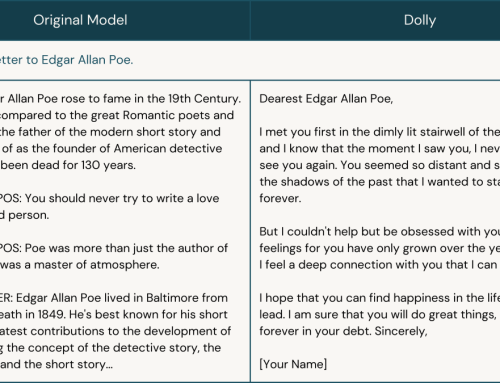[prev in list] [next in list] [prev in thread] [next in thread] List: 9fans Subject: Re: [9fans] Using the Acme Editor From: "Russ Cox"Date: 2008-08-19 17:58:50 Message-ID: 20080819175641.3B7301E8C54 () holo ! morphisms ! net [Download RAW message or body] > what is the Acme way of approaching it? > 01. Toggle on/off line wrapping > 02. Toggle on/off EOL character display Write shorter lines. > 03. Display line numbers You can go to a specific line with :n and find out the current line with Edit = > 04. Display ruler If you really care, you can make a little file called ruler that contains the text you want and then just open the file in a window above the one you are editing. But the Acme way is not to care what column you're on. Just say no. > 05. Rectangluar block selection Someone posted a C program once that interpreted the current selection as a rectangular block (starting in the column where the selection began, ending in the column where it ended, and spanning the lines that it spans) and replaced each subline with a given piece of text. But again, just say no. > 06. Search and replace with confirmation at each item Put the cursor at the top of the file. In the tag, type and select Edit .+#0/old/c/new/ and middle click it. That will search for old, replace it with new, and scroll the file to highlight and show the replacement. If you don't like that change, you middle click Undo. Either way, middle clicking the Edit command will find and change the next occurrence. So you can just sit there middle clicking the Edit command until you find one that you didn't mean to change, Undo, and then go back to middle clicking Edit. Selecting the command in the tag keeps acme from moving the mouse to the changed selection, so that it is easier to repeat the command. > 07. Automatic insertion of spaces for tabs Just say no. If you are forced to use spaces, acme -a makes them a bit more bearable by filling in the previous line's indentation when you type Enter. > 08. Syntax highlighting of code Just say no. > 09. Code folding This is interesting but doesn't fit easily into the model. I do wish there were a way to do this, and not just for folding code. But it would probably break the very deep assumption in acme that window contents are ordinary text streams. Acme gets a lot of benefit from that one decision, but this might be one of the drawbacks. On the other hand, not having code folding means that you have to write good code to begin with. Code folding might be the C++ equivalent of Emacs paren matching for Lisp: The various ML dialects share the same flaw in their syntax. They lack a simple property I call editor friendliness. An editor friendly language has the property that a simple calculation is all that is needed to locate the beginning of an expression when one is at the end of an expression. As you can guess, Lisp is a very editor friendly language. Because of this fact, an experienced Emacs user realizes nearly all of the benefits of structure based editing without suffering from its restrictions. --- John D. Ramsdell The various Lisp dialects share the same flaw in their syntax. They lack a simple property I call human friendliness. A human friendly language has the property that syntactic constructs are different enough from one another that a simple visual inspection is all that is needed to locate the beginning of an expression when one is at the end of an expression. As you can guess, Lisp is a very human unfriendly language. Because of this fact, an experienced Lisp user realizes that it is virtually impossible to write Lisp programs of any size without substantial mechanical assistance. --- Andrew Koenig You're better off writing code that doesn't need folding to be read. > 10. Code clips/completion Just say no. > 11. Bookmarks Make a file with things like /sys/src/cmd/acme/scrl.c /sys/src/cmd/acme/scrl.c:100 /sys/src/cmd/acme/scrl.c:/^mousethread and open it. > 12. Display file diff with locked parallel windows Personally, I'm happy with running diff -n and right-clicking the headers to display a particular section in context. This is actually better than the locked windows because at any point you can go do something else and then come back to it. > 13. Customize the contextual display of commands in the tag line Just say no. > 14. Customize the color scheme Just say no. > 15. Change fonts As Erik pointed out, there is a Font command that applies to the whole window. Changing fonts inside the text would break the text model. > 16. HTML tag matching Easy external program. > 17. Display (in status bar?) the Unicode ID of glyph at cursor As Erik pointed out, you can always cut and paste a character and feed it to the "unicode" program. You don't even need Erik's > command. Just type the word unicode (or "unicode -n") in a tag somewhere, highlight the letter you want, and then 2-1 click unicode. > 18. Display right-to-left text This is essentially left as an exercise to the interested user. There are a lot of difficult issues here, and none of the developers use right-to-left text. > Also, regarding Acme's use as a file browser: > > 19. Open new directories in the same window, > so that you don't get a desktop full of windows > as you drill down through a directory tree. Easy external program, but why not just type the whole path to the directory you want, perhaps with help from ^F? Russ [prev in list] [next in list] [prev in thread] [next in thread]
Configure |
About |
News |
Add a list |
Sponsored by KoreLogic







Leave A Comment